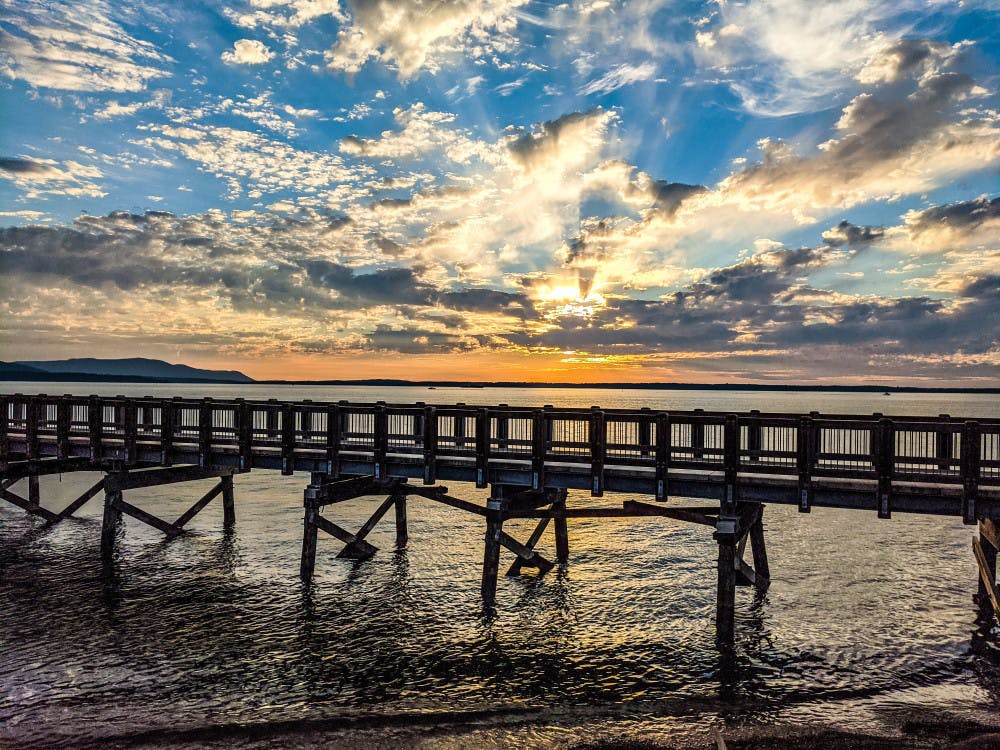State law mandated cleanup on two sites along Bellingham Bay in development, city turning into community space

Watching a bright sunset disappear over the ocean from a Bellingham beach has become a favorite local pastime. With two historically-contaminated cleanup sites being remediated and developed into Cornwall Beach Park, the community can look forward to a new sunset viewing area.
The Cornwall Avenue Landfill and R.G. Haley sites are roughly 17 acres of land that meet the Bellingham waterfront, located on Cornwall Avenue and parallel to Boulevard and Wharf Street.
The park plan was originally released in October 2014 by Bellingham’s Parks and Recreation Department. Cleanup construction on each site is expected to finally begin in September 2021 or 2022.
It has been a city-wide effort, years in the making.
Before the Cornwall Avenue site became a landfill in 1953, wood treatment and lumber work were done on each site starting as early as the 1880s, according to the Washington State Department of Ecology’s site information page.
After an oil spill at the R.G. Haley site and a flow of contaminated groundwater was found at the Cornwall Avenue Landfill, an “Interim Cleanup Action Plan” was issued by the Department of Ecology in both 2001 and 2011, respectively.
Ian Fawley, community outreach and environmental education specialist for the Washington State Department of Ecology, said interim cleanups occur if there is an “immediate concern for human health in the environment.”
Washington’s environmental cleanup law, the Model Toxins Control Act, required the sites, by law, to follow a process during emergency cleanups to remediate each site’s contamination.
Other members of the community have recognized the historical environmental impact of the two sites on Bellingham Bay.
Tammi Laninga, an associate professor of environmental studies at the College of the Environment, oversaw her class as they executed their own environmental impact assessment on the city’s Cornwall Beach Park last December.
The research examined the potential impacts to the environment and whether remedial action is taken.
“There potentially could be more negative impacts to the environment by not taking any action, by not building the park, then if they did build the park,” Laninga said.
The assessment also concluded the current conditions of contamination are unsustainable for the long-term health of Bellingham Bay, stating, “with no intervention, the site will remain contaminated, with the potential for water run-off pollution into Bellingham Bay.”
Each site has completed investigations, studies and a cleanup plan for the present contamination. The design phase is next in the cleanup process, and where both sites currently stand.
The design phase develops how the cleanup will be done and addresses every issue present at a contaminated site. Craig Mueller, project engineer for Bellingham Public Works Department, said the process requires a lot of coordination with the Parks and Recreation Department in order for park development to be successful after the cleanup.
“Several aspects of [the design] need to be coordinated with the cleanup,” Mueller said. “So what we are doing with the cleanup is we’re trying to rough grade it as much as possible to accommodate the future park.”
Nicole Oliver, director of the Parks and Recreation Department, also emphasized the necessity of coordination between cleanup design and park development.
“There's all these different components coming together,” Oliver said. “We're making really good progress this year I would say, and we're getting pretty close.”
Oliver noted that permits are required before construction starts, and the cleanup will take roughly two years. Mueller said lengthy planning is required before physical work can begin to ensure safety from previous contamination and a cohesive park design.
In terms of the complete Cornwall Beach Park, the community can expect a similar experience to that of Boulevard Park, however in a much bigger space, Oliver said.
“It's going to be really beautiful,” Oliver said.
Brian Gouran, the director of environmental and planning services for the Port of Bellingham, said while these types of projects take a long time, they produce great community spaces.
“It's just gonna be a really huge asset [to the] community,” Gouran said. “It's just exciting to be involved [in those] projects.”
Cassandra Childs, a born-and-raised Bellingham local, said she finds the availability of safe waterfront space to be a great addition to Bellingham’s environmentally-conscious community.
“I definitely think that we and Whatcom County are very environmentally conscious and very green-conscious,” Childs said. “I think that the people in Bellingham really appreciate these community spaces where they can go out into nature and they can experience it.”





